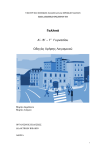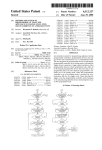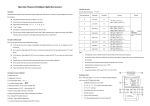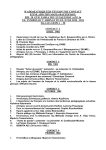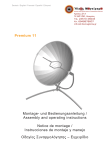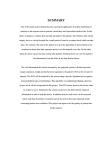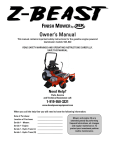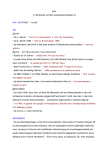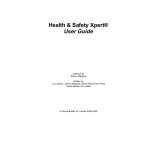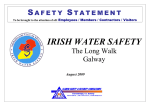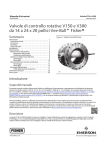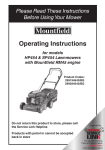Download FIELD APPLICATIONS OF SAFETY MANAGEMENT IN SMALL
Transcript
FIELD APPLICATIONS OF SAFETY MANAGEMENT IN SMALL
CONSTRUCTION PROJECTS
Dissertation submitted as part requirement
for the Degree of Master of Management in Construction
By
CHARIKLEIA ZISI
SUPERVISOR
ANGELOS DAVARIS
ΤEI PIRAEUS – KINGSTON UNIVERSITY
DEPARTMENT OF CIVIL ENGINEERING
SEPTEMBER 2007
CONTENTS :
1. Introduction
Page 2
1.1 Aim
Page 2
1.2 Objective
Page 2
2. Problem description
Page 3
2.1 Sources – Material
Page 3
2.2 Methodology
Page 3
2.3 Statistical analysis
Page 4
3. Situation analysis
Page 27
3.1 Estimates of the analysis
Page 27
3.2 Results (Risk assessment)
Page 35
4. Conclusions
Page 41
5. Acknowledgements
Page 46
6. References
Page 46
7. Appendix
Page 48
7.1 Certification from “Τ.Ε.Ι. ΠΕΙΡΑΙΑ”.
7.2 Mrs. Siba’s authoritization.
7.3 Mrs. Siba’s sample questionnaire (translated in English).
7.4 Map extracts.
7.5 Twelve completed questionnaires.
1
1. Introduction
It is statistically proved that one out of three working people who lose their life
during work, belongs in the construction area. This specific field is undoubtedly the
most dangerous for the work-force due to particularity, intense activity fluctuations,
seasonal character, work in difficult conditions etc. Moreover, the probability of an
industrial accident in technical works is double, compared with the average of all
other fields.
The most common causes of working accidents in construction sites are :
-
people falling from heights.
-
objects’ falling.
-
load management
-
technical works machinery
The recording of the existing situation in small construction projects in Greece, will
determine the degree of conformity or nonconformity regarding safety measures.
1.1
Aim
The point in writing this thesis, is to provide an assessment on the Safety
Management Systems concerning small projects. To this end, a statistical approach is
in order, to conclude to some estimates for evaluation.
1.2
Objective
The methodology to be followed will be to establish the research, starting from a
small sample given by a questionnaire and analyzing the results according to the
group classification. At a second stage, the most important factors of
nonconformities will lead to suggestions for implementation.
2. Problem description
2
2.1 Sources – Material
The basic sources that will be used in this thesis, are :
1) The user manual regarding health and safety, made out by Spyridon Dzouropanos.
2) The indicative site inspection of health and safety regulations composed by Maria
Siba.
3) Bibliography (Greek and foreign).
4) Research in the Internet.
5) Interviews and discussions with people relevant to construction works in small
projects.
2.2
Methodology
Initially, an elaborate description of the system (H.S.F. –H.S.P.) applied in Greece, is
on demand. According to the Presidential Decree 305/96 which is adjusted to the
directive 92/57 of the European Union, the constructor of the project’s Client is
responsible for the syntax of the aforementioned system attributed into a file.
H.S.P. (Health and Safety Plan)
It defines the precautions and restrictions towards risks incurred, during the
construction stage at workers and all others who are involved in the project.
The design of the above system is mandatory whenever :
- A Coordinator is necessary at the study phase, that is, in the case where more than
one workshops are occupied in the construction.
- Activities with particular hazards are foreseen to arise.
The data consisting H.S.P. are going through persistent revision and enrichment
during the progress of the technical work based on the historical study. Changes are
formed, depending on weather conditions, new geological situations that arise or
even new architectural, static, electromechanical experience developed. Its’ value
and usefulness ends after the completion of the project.
3
H.S.F. (Health and Safety File)
It aims to prevent and eliminate risks for those who are potentially employed in the
future with the preservation or the project’s repairs.
The folder includes :
a) The project’s record (plans and technical description).
b) Data accompanied with instructions relevant to health and safety issues, for
subsequent works during the whole project’s life cycle (preservation, conversion,
clearing etc.).
To complete the H.S.File it has to be updated by the Coordinator of execution,
comprising with the project’s real elements as it was constructed. Finally, it ends up
to the Client’s possession and every owner of a private project owes to have a copy
of it.
Last but not least, both H.S.P. and H.S.F. are obligatory for the construction permit
and are kept with the responsibility of the General Constructor.
2.3 Statistical analysis
Taking into consideration the two basic sources, Mr. Dzouropanos and Mrs. Siba for
this thesis’ research, the latter would be preferred for a number of reasons.
In the first case (Mr. Dzouropanos), the manual is addressed to young engineers who
are working for the first time in construction activities. The chapters that follow
illustrate a detailed reference to every kind of activity carried out in a building site. It
is obvious that so many questions to be answered, would demand considerable time
on behalf of the person giving this sort of information. In some circumstances they
are not all needed, since the type of work is irrelevant to them.
Particularly for small construction projects, which are the subject of this dissertation,
a minor statistical sample is more than enough to reach to satisfactory conclusions.
Based upon Mrs. Siba’s indicative checklist, one can gain time and accomplish an
integrated picture of the extent that health and safety issues are followed.
4
Mrs. Siba’s sample (translated in English) is being presented in the appendix (7.3).
The permission for the distribution of this questionnaire is being given by the author
Mrs. Siba. [ see appendix (7.2) ].
Furthermore, during the analysis it will be ascertained whether consultants,
professionals and workers are aware of the standards required according to Greek
legislation. Selecting a survey sample of only twelve construction sites, a statistical
analysis from the experimental facts will be formed.
To this end, the statistic method Student’s t-Distribution will contribute to the results
concluded, which is a special case of the generalized hyperbolic distribution. This
kind of probability distribution is based on the mean of a normally distributed
population when the sample size is small. Particularly for this survey, a convenience
sample is applied because precision is not the point but only facts that are compared
to real situations. Other reasons for choosing this method was that time and money
were not in abundance, therefore twelve questionnaires were used.
The measures mentioned in these questionnaires focus on the next topics :
•
Personal Protective Equipment
The equipment together with the accessories that a worker needs to wear or hold, in
order to be protected from risks during work, is called Personal protective
equipment. In all cases it must have the sign C.E. (Conformite Europeene) which is
common for all countries of the European Union. The product or the equipment that
has this sign is being examined and it can be circulated in the countries of E.U. and
used safely, if the instructions for use and installation are followed.
It is used in certain circumstances :
- When all other means of measure has been depleted in order to eliminate risk.
- Whenever used as a temporary measure, in case of extraordinary risks.
- While used as a temporary measure, until permanent measures are completed.
By the usage of Personal protective equipment, the risks confronted are listed
below :
-
Objects downfall
5
-
Downfall from heights
-
Hitting, striking, squeezing parts of the body with objects or machinery.
-
Cutting, scratching
-
Slipping
-
Electrical risks
-
Natural factors (Temperature, heat, flames, cold, radiation, noise)
-
Chemical factors (Dust, fumes, fog, steam, gas)
-
Biological factors
What has to be mindful during the use of this kind of equipment is :
a) It must be suitable for the user
All people do not share the same anthropometric characteristics, so Personal
protective equipment has to be adjusted according to the demandable size.
b) It must be clean and well maintained
In cases where Personal protective equipment is not clean, it might cause infections
to the user and extra care should be taken for its storage so that conditions prevailing
there do not change their properties.
c) The workers using Personal protective equipment ought to be aware of the
instructions for proper use.
For each part of the body and for each risk there are certain means of protection
available. The most common are mentioned below :
1) Protective equipment for head
Protective helmets appropriate for use in worksites, made out of durable materials
against percussion. They cover the head from object’s downfalls and striking onto
things. Apart from helmets there are also light protective means for the head, such
as caps manufactured by more flexible materials.
2) Protective equipment for hearing
6
This kind of equipment involves small bullets put on the ears to protect them from
high noises. Their synthesis is usually cotton or some sort of plastic material that
can be adjusted to the ear size of the user. The only disadvantage is that if the
user’s hands are not clean during the placing, germs might be transferred in the
ear’s interior.
2) Protective equipment for the eyes and the face
To protect the eyes from hurling objects or materials such as metal filings, dust,
caustic liquids etc., there are many types of glasses in the market with arms,
masks, even protective glasses from radiation (X, laser, ultraviolet, infra-red).
4) Protective equipment for respiratory channels
They protect human organism from breathing chemical or biological factors, by
the use of various mask types which prevent the entrance of dust and gases.
5) Protective equipment for hands and arms
For this occasion there are gloves in order to protect hands from cutting, chemical
factors, heat, as well as specific electrical activities. All gloves do not provide the
same protection, therefore depending on the activity, the worker must choose the
appropriate ones. After use, they need to be washed thoroughly and dried with
cotton, not upon radiators because heat increases pervasion, so they can be ready for
next time.
6) Protective equipment for feet and legs
7
This means of protection is obviously very old, since it is well known that ancient
Greeks used leggings for their protection. Depending on the type and nature of
work there are many kind of shoes used by the workers which are described in the
following :
- Pumps, bootees, safety boots.
- Shoes with additional protection at the end of the foot supported with metal
covering.
- Special shoes with rapid release of the laces.
- Particular shoes with electric insulation.
- Specific shoes durable at heat, protective from cold, shocks, electrostatic loads.
7) Protective equipment from falling
•
Full-body safety belts
The most important means of protection against falling is the use of full-body
safety belts. They are used only in the following situations :
- When the labor cannot be done in any other safety way.
- Whenever there is an emergency.
- While used as an additional measure, provided that general protective measures
have been taken.
For security reasons, safety belts ought to be used according to certain rules listed
below, otherwise they may be of great danger :
8
a) Before use, they should be fastened from a point higher of the work’s position.
b) In cases where the work demands the laborer’s movement, there must be the
appropriate infrastructure and attachments to ensure this potential.
c) The safety belt should not allow the worker’s free fall over one meter.
d) A safety belt should not only cover the waist but other parts of the body as well,
like the back etc. in order to prevent serious damage to the waist during a free fall.
e) If a worker uses a safety belt, it is wise enough to have another person nearby to
provide help in need.
•
Safe portable ladders
Quite often it is necessary to do construction work, repairs, inspections etc. in high
points where there are no steady labor spots. In such cases and to work safely, one
has to take in mind the quality of the ladder, the correct placing and its’ proper use.
a) Good quality
Specifically, wooden ladders must be manufactured from healthy wood, without
knots and splitings, because they are most of the times the reason for breaking down.
Furthermore, neither stucco nor paint should be placed on the wooden ladder, so its
condition can be optically checked. The steps ought to be fitted in the poles and not
nailed, whereas the distance between two steps should be less than 0.30m.
In addition, ladders which are ruined with broken steps must not be used and never
join two ladders (binding them together). It is preferable to use portable ladders
manufactured specifically with extensions for higher points.
b) Correct placing
9
Before placing a ladder it is of significant importance to select the appropriate one
for the corresponding job. For this reason, the ladder to be chosen should not be too
big or very small, but the right size so that the user does not overstretch his body.
In order to place a ladder under safety conditions, the floor on which it is supported
must be clean from other objects and not slippery. The best positioning of the ladder
is when the angle formed with the ground is between 68o - 75o or practically the
inclination is one (1) to four (4), meaning that in height 4 meters, the distance
between the base and the wall is 1 meter.
They should also project 1 meter above the point where the task has to be done and
be used only up to two steps from the top. In addition, it is rather dangerous to lean
the ladder in front of doors and windows that are opening towards this direction.
c) Proper use of a ladder
To avoid any injuries, the user of a ladder must be careful of the following :
- He must always face the steps while climbing and descending.
- If tools are needed, they should not be kept with the hands, but put in suitable
cases.
- It is necessary a second person to be present so as to hold the ladder in case it slips.
- When somebody is on it, the centre of gravity should be between the two poles for
better stability.
- After use the ladder must be placed lengthwise to the ground.
- It should never be used when set in a horizontal position as a work floor.
- For work need to be done over 6 meters height, the user should wear a safety belt.
- According to legislation, it is forbidden to use a metallic ladder for activities which
are close to electric power.
•
Scaffolding
There are some jobs that cannot be accomplished by the help of a portable ladder.
For this purpose scaffolding is applied, which provides greater certainty compared to
ladders. Regarding this as an issue, the types accompanied with the technical
specifications and the basic principles concerning safety, will be mentioned below :
10
1) Types of scaffolding
They are distinguished into :
a) Stationary scaffolding
These can be either wooden or metallic and are used for inside activities at a height
above 3.50 meters and outside activities at a height over 4.00 meters. Particularly
wooden scaffolding is installed up to 10 meters high.
b) Movable scaffolding (trestles)
They can also be wooden or metallic and are used for either inside or outside works
at a height below 3.50 meters. It is though dangerous and prohibited by law to use
trestles at balconies.
c) Movable metallic scaffolding (towers)
Whenever doing inside works at heights up to 12.00 meters, or outside works at
points until 5.00 meters high, then towers are recommended as long as the technical
specifications are followed :
- height < triple of the base’s smallest side
- brake at the 4 wheels
- climbing ladder to the work ground
- total cover (beaming) of the work ground
- protection of the work ground from falling
11
d) Suspended scaffolding
These are usually installed when no other means of scaffolding can be used, like the
cleaning of buildings’ external sides, the lagging with materials for buildings’
external sides etc.
2) Basic principles concerning safety
- The construction and the removal of metallic scaffolding, should always be done
according to the manufacturers’ instructions and specifications by well trained
people.
- Stationary scaffolding ought to be secured from horizontal movements and leaning
firmly on the building, in order the labor upon it, to be safely done.
- The ground where scaffolding is placed, must be solid, steady with adequate
strength.
- Work grounds’ least acceptable width is 0,60m (2 beams of 30cm) for simple labor,
whereas for activities involving material placing it is 0,80 m – 1,10 m.
- For every work ground there must be a horizontal handrail at 1m middle space, or
any other safety layout at the scaffolding’s edges.
- Each worker has to use a ladder or a safety structure to have an access to the
scaffolding and not climb upon it.
- A protective porch is needed for pedestrian passage way and burlap or net for the
neighbors’ safety.
- It is forbidden for a scaffolding to be close to aerial wires.
- No work is allowed on scaffoldings if weather conditions do not permit it.
•
Basket carrying lifting machines
12
Certain works at heights are most preferable to be done with special basket carrying
lifting machines instead of portable ladders and scaffolding. These machines enable
people to work with safety provided that they are manufactured under strict
specifications. As far as the installation, handling and preservation is concerned, the
rules applied are the same as those for generally lifting machines mentioned further
down.
•
Lifting machines
Within the construction site the use of lifting machines is most common in order to
carry heavy loads or materials. Some of them are the derricks, the winches and other
relevant devices with lifting hooks. To be more specific, all the basic causes of
accidents due to risks involved and safety measures to be taken, will be analyzed
below :
a) Basic causes of accidents due to risks
Activities performed via lifting machines, hide risks capable of injuring the handler
or any other person that might be around. Responsible for most accidents are risks
such as :
- The braking of wire ropes or other parts of lifting machines.
- The fall of loads during transfer or lifting.
- The shifting or wrong installation of lifting machines.
- The overloading or mistaken handling of lifting machines.
- People’s circulation in areas where lifting machines run, or beneath the lifted loads.
- The lifting machine’s damages and parts extracted due to overloading or other
causes.
- The contact of a lifting machine with electric networks.
b) Safety measures
Lifting machines according to their power or the energy pattern with which they
function, are classified into categories and ought to be operated only by licensee
handlers. Apart from this prerequisite, there are a number of precautions to have in
mind during the use of lifting machines :
- They must be installed and checked regularly by well trained people.
13
- They have to be well supported to the ground with counterweights, flanges, ropes
etc. even if they are not functioning.
- The mechanical equipment should be disconnected from power at the end of the
day.
- An indication of the maximum weight and technical principles are in order.
- In case they are destined for lifting people, this should be predetermined.
- They should be used only under suitable weather conditions and examined after
intense bad weather.
- During repairs, lifting machines must be in complete halt and engines out of
function.
- Loads should neither be ascended and descended with great speed or rapid motions,
nor under angle .
- They are not manufactured for overloading.
- It is forbidden to use ruined wire ropes and unsuitable hooks or to transfer loads
that are loose tied.
- In no circumstances should people be present underneath loads that are lifted or
transferred.
- They are prohibited to operate close to electric aerial wires, though if it is
necessary, the orbit has to be within limited safe distance.
•
Labor equipment
In some works, machinery, equipment and hand tools are of high priority. To this
end, they ought to be :
- Well designed and manufactured taking into consideration health and safety issues.
- Maintained in good condition for operation.
- Used only for the purpose of manufacture and by authorized well trained people.
- Supplied with protective shields and covering.
14
- Kept in a place where they are accessible, easy to check and to be found.
Tools are designed by manufacturers with instructions for the handlers, who are
obliged to follow accurately. Furthermore they are responsible for :
- Protecting themselves from sharp ends, by keeping tools into cases especially
during transportation.
- Not having pointed or generally any other tools in their pockets.
- Not holding in their hands small tools, while using some other tool, because they
might be injured.
- Being extra careful with tools that can slip and cause an accident.
- Not being distracted by anything during work.
Electrically driven hand tools are most common in the construction site like drills,
laps etc. This kind of machinery is a major source of danger, due to the connection
with electric current. For safety reasons certain technical specifications are in order :
- Portable electrical tools ought to be operating in low potential to avoid risk of fatal
electrocution.
- Every electrical tool must be grounded except only if they are “totally insulated” or
“double insulated” and grounding is not necessary. Grounding needs to be
incorporated in metallic coverings and as security against damaged cables, where
wires enter the tool.
- All electrical tools have to be inspected and preserved regularly by a qualified
electrician who keeps detailed records.
Risks that might occur during the handling of electrical tools are :
- Whenever they are used without safety systems, their movable parts – accessories
(cutting disks, grinding, drills, etc.) can cause an accident to the handler and to others
working close there.
- In cases where the tools are used with different parts from those that the
manufacturer has planned, then those parts may break down and injure the handler.
15
- During the working process, the throwing parts of the material elaborated such as
dust, filings might harm the user’s health and particularly the eyes.
•
Metal Soldering – Welding
1) Electric soldering
During works that demand electric soldering, certain risks are involved due to
produced gases, radiation emission and electrocution :
- Electric soldering gases
The exhalation and fumes such as oxides of various metals or other chemical
analysis created by electric soldering, even in small quantities, may be extremely
dangerous for the user and others in the surrounding area. Moreover, in cases where
soldering is being done in surfaces which are coated with alloy leaden, fluorine or
zinc, the fumes that emerge can harm the individual’s health.
- Radiations
According to the electric intensity, there are three types of radiation at electric
soldering :
a) Ultraviolet radiation, which is usually invisible and affects the skin’s cells,
therefore very dangerous. Workers may be also affected indirectly, when this kind of
radiation reflects in activities where there are not any absorptive surfaces.
b) Infra-red radiation, which is also invisible and affects mostly the eyes or in some
cases where it causes burns, without being seen immediately.
c) Lighting radiation, which is something that can be seen and might cause blurring
in the eyes.
- Electrocution
16
A source of danger generated by electric soldering works, is the circuit’s entry –
outlet as well as the metallic parts of the device with everything else that accompany
it.
General protective measures that ought to be taken in order to eliminate risk are :
• Electric soldering works must be done only by licensee handlers which are entitled
with the appropriate license, issued from the Ministry of Industry after previous
service as an assistant and examinations.
• Inflammable materials should not be anywhere near the working area.
• A fire-extinguisher has to be ready for directly use in case of a fire.
• Depending on whether electric soldering works need to be done in a closed or very
limited space (tanks, manholes), well ventilation and air renewal is on demand. In
addition, another person has to be outside of this specific area to follow the work.
• The handler is obliged to use personal protective equipment like a suitable overall,
leather shoes, leather apron, leggings, gloves made from leather or other appropriate
material, mask with glasses and a cap for head protection.
• To absorb the fumes and gases, a general and local system has to be placed close to
the point of electric soldering and beneath the worker’s face.
2) Welding
A welding device consists of cylinders, elastic tubes, non-return safety valves and a
blowlamp. The most important risks a user faces, are mentioned below :
- If cylinders are strongly hit or overheated, then a serious accident can happen.
- In cases where the cylinders are exposed to the sun or placed close to a fireplace,
then an explosion might occur.
- Never should the organs that might come in contact with the oxygen be greased,
because of great danger.
To avoid any accidents, the following safety measures are in order :
• Whenever welding is taking place in a closed or limited space, artificial airing
provided by papier-air should be ensured.
• Around the points from welding works, screens have to be placed for the workers’
protection against radiations.
17
• The transmission of the cylinders should not be done by the use of cranes that pick
the loads with a magnet, instead suitable machinery must be used for safe unloading.
• In the place of use, cylinders ought to be set upright or almost straight and fastened
with chains in partitions, poles etc.
• Cylinders must be stored in particular manufactured areas, separately those that
contain acetylene from those that contain oxygen. Segregation should also be done
between empty and full cylinders.
• To protect himself, the handler has to wear personal protective equipment during
welding: overall, leather shoes, gloves made from leather or other appropriate
material, black absorbent glasses and a cap on his head.
•
Fire - extinguishers
One of the most important safety measures during worksite’s preparation is the
installation of fire-extinguishers. Fire is generated whenever three elements coexist :
a) Combustible substance
b) Oxygen
c) High temperature
If one of these elements does not exist, then there is no fire. Consequently,
prevention and fire-extinguishing are achieved by the removal one of the three
factors. To avoid fire, the reasons causing it ought to be mentioned :
-
Bare flames
-
Red-hot surfaces
-
Electricity
-
Sparks
-
Physical or chemical phenomena
-
Unidentified causes
18
In case of a fire in the construction site, a systematic procedure is followed in order
to avoid spreading. Fire can be transmitted by various ways such as :
-
direct transmission via contact
-
transference or conveyance of heat through the air
-
particle ejection that are burning
-
radiation
Portable fire-extinguishers are distinguished into carbon-dioxide (CO2), dried dust,
water, foam and are manufactured to deal with small size fires. Fire extinction must
be enforced from the outset and in circumstances where one is absolutely sure that he
can manage to do so by himself, then he has to use the suitable means. First of all,
the correct fire-extinguisher must be chosen and the next step is to replace the safety
valve and put it in function.
Every worksite needs to be equipped by the necessary fire-extinguishing means
according to the machinery and the materials being present. In addition, the
appropriate safety marking shown below (always presented in red color),
accompanying the fire equipment is of great importance too.
•
Safety marking
19
In a construction site, safety marking is obligatory so that workers are informed and
warned of a potential hazard. Moreover, safety marking is divided into permanent
and occasional marking. In the first occasion, there are many categories of signs,
each one of which is characterized by a specific color and geometrical pattern The
most frequently used are listed below :
a) Prohibition signs (rounded with red exterior and black interior colors)
-
Smoking is prohibited.
-
The use of a bare flame and smoking is forbidden.
-
No road for pedestrians.
-
Extinguishing with water is prohibited.
-
Not drinkable water.
-
Entrance is prohibited to non authorized people.
-
No road for vehicles handling loads.
-
Do not touch.
b) Obligatory signs (rounded with blue color and white filling)
-
Compulsory eye protection.
-
Compulsory head protection.
-
Compulsory ear protection.
-
Compulsory respiratory channels protection.
-
Compulsory leg and feet protection.
-
Compulsory hand protection.
-
Compulsory body protection.
-
Compulsory face protection.
-
Compulsory protection against falling.
-
Compulsory passage for pedestrians.
-
General obligation.
c) Warning signs (triangular with black exterior and yellow interior colors)
-
Flammable substances or/and high temperature.
-
Explosive substances.
-
Toxic substances.
-
Erosive substances.
-
Radioactive materials.
20
-
Suspended loads.
-
Danger of electrocution.
-
Danger from falling.
d) Fire-extinction signs (square with red color and white filling)
-
Fire hose.
-
Ladder.
-
Fire-extinguisher.
-
Telephone for fire fighting.
-
Direction that must be followed.
Occasional marking includes :
a) Lighted signs
They are characterized by :
-
appropriate bright contrast (without any blurring)
-
a bright surface of a united color, containing icon-symbol
-
duration and gleam frequency
-
non simultaneous use of two lighted signs (confusion)
-
secured provisioning in case of normal provisioning pause
-
inspection of good operation during installation and in regular time intervals.
b) Acoustic signs
They are characterized by :
-
an acoustic level that is higher than environmental noises
-
easy recognition and distinction from other environmental noises or other
acoustic sign
-
floating frequency
-
non simultaneous use of two acoustic signs (confusion)
-
secured provisioning in case of normal provisioning pause
-
inspection of good operation during installation and in regular time intervals.
c) Oral announcement
This kind of announcement is accomplished between one speaker or a transmitter
and one or more listeners. The characteristics that accompany an oral announcement
are :
21
-
short, simple and explicit messages
-
knowledge of the language by the people to whom the announcement is
addressed
-
use of code-words for example: start, end, move, withdraw etc.
d) Signs with gestures
A special educated person called signaller undertakes to give the signs with gestures
to the handler who receives them. The most commonly used are :
-
General gestures ( START, STOP, FINISH )
-
Vertical movements (LIFTING, DESCENT, VERTICAL DISTANCE)
-
Horizontal movements (MOVE, WITHDRAW, RIGHT, LEFT, HORIZONTAL
DISTANCE)
-
Danger (DANGER)
•
Calendar of safety measures
According to Greek legislation, the calendar of safety measures concerns private
technical works and has to be provided by the project’s contractor or subcontractor
but in cases where they do not exist, by the owner of the project. At the same time
with the issue of the construction permit and before the commencement of works, it
must be completed and attested by Directories, Departments or Labor Inspection
Offices. It is also compulsory for all projects in progress.
In advance notification is demandable in the following situations :
-
whenever the expected duration of labor exceeds 30 working days and
-
in cases where more than 20 workers are been occupied, or
-
whenever the expected works exceed 500 wages.
In all cases it has to be kept in a safe place at the construction site and if changes
occur, the calendar of safety measures must be informed accordingly. It is hold in the
worksite by the contractor’s or subcontractor’s responsibility but in cases where they
do not exist, by the owner of the project. Anybody who has a legitimate interest may
ask to have a copy of the calendar and attest it at the above mentioned services.
Those who are obliged to update the calendar are :
-
The supervisor engineer.
22
-
People appointed by the law to conduct an inspection concerning the results and
tests of this examination.
-
The qualified Technical Labor Inspectors that can specify any suggestions.
In a regular or extraordinary inspection at the worksite, the conclusions concerning
the deficiencies and risks in safety issues, are registered by the supervisor engineer.
He is also entitled to indicate the recommended safety measures by the law, as well
as his own initiatives for the improvement of working conditions and have them
written in the appropriate column of the calendar.
In consistent with the Presidential Decree 1073/81 (article 113), all construction sites
(private and public projects) regardless the size, are responsible to keep a calendar of
safety measures, which neither has to be attested nor is of a specific layout.
Nevertheless, some of the following safety rules ought to be inscribed :
-
A certification for the scaffolding’s completeness and stability given by the
supervisor engineer.
-
Inspections that have to be done, for activities to be continued after a calamity.
-
Inspections of trench’s slopes and their supporting.
-
The supervisor’s license for the installation of a lifting machine upon scaffolding.
-
Wire rope’s inspections and their repeated examination.
-
Inspections and repeated examination of the lifting machines.
Accident notification
In case of an accident, the employers and their representatives announce it within 24
hours at the peripheral departments of the “Technical and Health Inspection”.
Furthermore, the Police Authorities must be immediately informed in order to keep
data unchanged, to ascertain the accident’s causes and provide the proportionate
services to the misfortunate.
•
Demolitions
23
It is common sense that the demolition of any building, entails risks for the workers
and the people passing by. To this end, safety measures are in order following a
certain methodology :
- The appropriate precautions and procedures ought to be taken, as far as the disposal
of the remains is concerned.
- The planning and the supervision of the demolition works are of great importance
and that is why a qualified person is appointed.
- Before the commencement of a demolition, a thoroughly examination has to be
held to the terrain where the building was constructed, the frame and the walls which
carry the burden.
- All the water, electricity and gas supply must be cut, unless the situation demands
the maintenance of the above services, then they need to be properly covered.
- The prohibited area around the building being demolished, should be suitably
fenced with a barrier two meters high and signalized, so as the public is safe.
- In case there are installations containing flammable materials, it is necessary to take
into consideration special precautions against fire and explosion.
- Demolitions should be in halt during bad weather conditions especially in windy
days, because rickety constructions might collapse.
- Buildings which are being demolished have to be sprinkled with water regularly, to
avoid dust rising in the surrounding area.
- Every foundation wall used as a ground supporting wall or adjacent to a structure,
should not be demolished before the adjoined building is supported by buttresses and
other protective equipment.
- Depending on whether explosives are used for the demolition of basic sections,
extra protection should be taken concerning the safety distances agreed in advance.
- Walls ought to be demolished floor by floor, starting from top to bottom, whereas
in floor demolitions workers must be standing and moving upon boards or corridors.
•
Excavations
There are various types of excavations, such as wells, earthworks, underground
activities or tunnels. The general rules regarding excavations have to be notified in
24
advance to all those involved in the labor. To mention but a few, the safety measures
existing according to national legislation are listed below :
- It is of high priority to examine beforehand whether electricity, water, gas and
telephone networks go through the construction site which is due to excavating, in
order to seclude or remove them.
- The whole procedure of excavating must be planned and organized in such a way
including the supporting works.
- The terrain needs to be verified for its steadiness as well as the adjacent buildings,
other structures, roads, not to be affected by the excavations.
- All tasks developed by laborers should be supervised from the person in charge,
who is responsible of giving explicit instructions to them.
- It is forbidden to place or transfer loads, installations or equipment nearby the
excavation’s tips, where there is the possibility of a breakdown.
- On an occasion of underground excavations, the methods applied ought to be in
compliance with the risk involved, therefore rescue and evacuation techniques are in
order, in case of a fire, flood and rocks’ downfall.
- Supporting labor should be regularly checked to ascertain that the supports and
timber are in good condition despite the changeable weather.
•
Electricity
All the electrical equipment and electric installations regarded in the construction
sites are a source of danger for the workforce, if safety regulations are not enforced
in practice. Thus, it is imperative to comment on the most important risks, in order to
avoid any accidents :
- Before the commencement and during the construction’s works, every bare electric
cable noticed must be handled appropriately by a qualified person and not drawn
near from other workers.
- Each part of an electrical installation should have the appropriate size and
characteristics for the power’s requirements and specifically to endure at the working
conditions, so that they are not destroyed from water, dust, electrical, thermic or
chemical effects.
25
- Every section of an electrical installation needs to be manufactured, established and
preserved in such a way that the risk of an electrocution, fire and external explosion
is eliminated.
- All electrical appliances and outlets have to be clearly marked and to carry the
indication of the purpose and their voltage.
- In cases where the installation’s layout cannot be identified easily, then the circuits
and devices must be marked with inscriptions or other suitable means.
- Whenever it is a necessity, installations should be protected from thunders.
- Signaling and telecommunication lines, must not be found in the same props with
the lines of medium and high voltage.
- Warning labels have to be placed in suitable spots, so as to forbid the entrance of
non authorized people into electrical installation areas or handle electrical
appliances.
- Electrical equipment should be supervised before being operated, for reassurance of
proper functioning.
- At the end of works, electrical installations ought to be inspected, tested and the
results recorded in accordance with regulations.
3. Situation analysis
3.1 Estimates of the analysis
The procedure that needs to be followed is listed below :
- Collection of the desired information.
In order to reach to a satisfactory conclusion during the research, twelve
questionnaires of Mrs. Siba’s [ see appendix (7.5) ] were distributed to people
involved in the construction site. The vast area where the survey took place is being
presented in the map extracts shown in the appendix (7.4).
26
Yet, not all of them were friendly and cooperative towards the request to give their
opinion by completing the checklist. Even though a certification [ see appendix (7.1)]
explaining the reason of the survey was displayed, none the less some of them were
suspicious or overloaded with so much work that they would not spare the time.
In most cases, neither the safety technician nor the supervisor designer was present
during the activities at the worksite. All that was to be seeing were a few workshops
struggling to have a day’s work done and nothing else. However, the professional
engineers responsible for each construction project, accepted to provide the
necessary information.
- Elaboration and organization of the data.
A questionnaire with a concentrated percentage of “yes” and “no” answers for every
question, derived from all questionnaires is being presented in the following pages :
27
INDICATIVE & NOT EXHAUSTIVE
PEAK POINTS AT WORKSITE’S INSPECTION
COMPANY’S NAME :………………………………………………………
TELEPHONE : ……………………………………………………………….
WORKSITE’S ADDRESS : ………………………………………………….
SUPERVISOR ENGINEER : ………………………………………………...
WORKSITE MANAGER / NAME : …………………………………………
EXPERTISE : …………………………………..
WORKSITE’S PREPARATION
_ Calendar of safety measures - In advance notification
_ Health and Safety Plan (H.S.P.) - Health and Safety File (H.S.F.)
_ Protection from D.E.I.'s cables
● Application to D.E.I.
● Transposition
● Additional measures (boardings etc.)
_ Worksite's fencing
_ Pharmacy
_ Fire - extinguishers
_ Personal Protective Equipment
NOTES:
%
8
67
100
100
100
42
83
50
17
42
YES
1
8
12
12
12
5
10
6
2
5
NO
11
4
0
0
0
7
2
6
10
7
%
92
33
0
0
0
58
17
50
83
58
DEMOLITIONS
_Removement of fences - door and window frames
_Protective Equipment (helmets, full-body safety belts, glasses,CE).
_Protection of openings from falling.
_Licensee handlers of work-machines and equipment, where required.
_Protective boardings.
_Particular study, if it concerns a project with reinforced concrete.
_Implementation of the project's plan, if there are materials that contain amiantus.
* where there are scaffolding, fill in the section (scaffolding) of the present checklist
NOTES:
%
92
50
92
67
58
42
50
YES
11
6
11
8
7
5
6
NO
1
6
1
4
5
7
6
%
8
50
8
33
42
58
50
EXCAVATIONS – PROPPING UP
_Propping up slopes
_Fencing of excavation edges.
_Materials far away from excavation edges.
_Protection from falling of passages - bridging, with safety fences
(handrail and middle gap).
_Safe portable ladders.
_Use of Personal Protective Equipment (helmets etc. CE).
NOTES:
%
83
83
58
33
YES
10
10
7
4
NO
2
2
5
8
%
17
17
42
67
83
42
10
5
2
7
17
58
28
BUILDING FRAMEWORK
(electromechanical works, plasters, paintings,
marbles etc.)
_Protection from the ends of concrete slabs and formworks.
_Protective porch at the height of the ground's floor roof.
_ Sloping impervious boarding ("umbrella" according to builders, for worker's
_ Sloping impervious boarding ("umbrella" according to builders, for worker's
adjacent passages etc.)
_Protection from elevator's openings.
_Protection from stairwell's openings (landings, lanterns, openings between the
parts of a ladder).
_Use of Personal Protective Equipment (helmets, full-body safety belts, suitable
boots etc. , CE).
_Safe portable ladders.
_Certified equipment (machinery, tools etc.).
_Certification for installation and right operation of lifting machines.
_Checking of wire ropes.
_Licensee electrosolderers - oxygen welders.
_Equipment handlers with the necessary law licences.
_Cleanliness, settlement of circulation corridors (passages, ladders, corridors etc.)
_Safety marking.
_Elevators' installation
● Use of full-body safety belts or et cetera protective arrangements from falling
(attics, scaffolding etc.).
● Use of helmet.
● Assistant's work, at licensee's installators presence.
_Prohibition of trestle use at balconies. Their use can only be acceptable with
protective arrangements from falling (at one metre and between the balcony's floor and the one
metre and between above the trestle's work floor).
* where there are scaffolding, fill in the section (scaffolding) of the present checklist
NOTES:
LABOUR MACHINERY
_Certification for labour equipment.
_Licensee handlers according to law.
_Right operation and recent upkeep.
_Circulation licences.
_Number plates.
_Demonstrative facts of insurance.
_Payment proof of yearly circulation charges.
NOTES:
29
%
YES
NO
%
50
25
6
3
6
9
50
75
33
4
8
67
100
67
12
8
0
4
0
33
67
8
4
33
83
58
33
67
17
42
75
17
25
0
10
7
4
8
2
5
9
2
3
0
2
5
8
4
10
7
3
10
9
12
17
42
67
33
83
58
25
83
75
100
25
83
3
10
9
2
75
17
25
3
9
75
%
58
75
83
92
100
58
58
YES
7
9
10
11
12
7
7
NO
5
3
2
1
0
5
5
%
42
25
17
8
0
42
42
SCAFFOLDING
_Wooden scaffolding at height <10m.
_Scaffolding Safe Securing (pole at bottom screws and hard horizontal ground and well rammed
down earth).
_Sufficient and safe connections with the building.
_Protection of neighbours from pollution and accident (burlap, protective boarding, pedestrian
passage way).
_Workgrounds width 0,60 m (2 beams of 30 cm), for simple labour.
_For particular labour grounds of bigger width.
_Protection from falling at the workground ("back").
_STOP (horizontal handrails at 1m middlespace (or other safe layout) at the
scaffolding's edges.
_Towers (movable scaffolding)
● height < triple of the bases's smallest side
● brake at the 4 wheels
● climbing ladder to the workground
● total cover (beaming) of the workground
● protection of the workground from falling
_Certification of completeness and steadiness from the Supervisor Engineer and
the Constructor.
_Certification on testing from Y.B.E.T. type and for imported scaffolding from
a recognized conveyor from the official authorities of the country of origin.
_Study on each scaffold except for the one with a workground's width 60cm that
exclusively supports workers and direct used materials.
NOTES:
%
25
58
YES
3
7
NO
9
5
%
75
42
92
42
11
5
1
7
8
58
58
42
42
42
7
5
5
5
5
7
7
7
42
58
58
58
75
58
67
25
75
25
8
9
7
8
3
9
3
1
3
5
4
9
3
9
11
25
42
33
75
25
75
92
8
1
11
92
8
1
11
92
HAND TOOLS
_Certification.
_Tools and cables in good condition.
_Safe storage and transportation.
_Fenders.
NOTES:
%
75
100
100
75
YES
9
12
12
9
NO
3
0
0
3
%
25
0
0
25
ELECTRIC BOARD
_Security (lock)
_Earth grounding
_Non-electrocutative switch.
_Placing in a cupboard.
_Written data of the licensee electrician in charge.
NOTES:
%
50
100
100
92
58
YES
6
12
12
11
7
NO
6
0
0
1
5
%
50
0
0
8
42
30
The data obtained is further processed by the help of the Student’s t-Distribution
methodology.
Standard deviation
S = σ2 = r / r-2
where r = n-1 and for n = 12
2
S = σ = 11 / 11-2 ,
then
r = 12–1 = 11
S = 1,222
At 95% confidence and sample mean of 11 taken from a sample set of 12
(11 degrees of freedom)
tn-1 = t11 = 1,796
Upper confidence limit (UCL)
UCL1-a = xn + (ta,n-1 · S) / √ n = x 92 + (t11 · S) / √n
UCL92% = 92 + 1,796 · 1,222 /
√12
( 92% = percentage of non
implementation )
UCL92% = 92 + 0,63 = 92,63
- Systematic presentation of the statistic sample (tables).
The conclusion arising from all the above is that, the deviation or error from the
population’s mean (0,63) is added to the mean of every question. Thus, in TABLE 1
shown below, all questions from the questionnaire have been classified in declining
order, according to their non-implementation percentage.
- Conclusions extracted from the statistical analysis.
Analyzing the facts, it is obvious that percentages between 70 & 90 are essential
nonconformities, while those between 40 & 70 are less significant. In the first case
with the high percentage, it means that people involved in the construction site are
unaware of the legal standards applied, or are intentionally taking the risk themselves
by not complying with the rules. For instance, fire – extinguishers, Calendar of
Safety Measures and Safety Marking is in most circumstances the omission. In the
31
latter, where the percentage is lower than 70 and in this particular survey it is 60 out
of 75
32
TABLE 1
PROJECTS' GROUP
4. BUILDING FRAMEWORK
1. WORKSITE'S PREPARATION
6. SCAFFOLDING
6. SCAFFOLDING
6. SCAFFOLDING
1. WORKSITE'S PREPARATION
4. BUILDING FRAMEWORK
4. BUILDING FRAMEWORK
4. BUILDING FRAMEWORK
4. BUILDING FRAMEWORK
4. BUILDING FRAMEWORK
4. BUILDING FRAMEWORK
6. SCAFFOLDING
6. SCAFFOLDING
6. SCAFFOLDING
3. EXCAVATIONS - PROPPING UP
4. BUILDING FRAMEWORK
4. BUILDING FRAMEWORK
1. WORKSITE'S PREPARATION
1. WORKSITE'S PREPARATION
2. DEMOLITIONS
3. EXCAVATIONS - PROPPING UP
4. BUILDING FRAMEWORK
6. SCAFFOLDING
DESCRIPTION
● Use of full-body safety belts or et cetera protective arrangements from falling
(attics, scaffolding etc.).
_ Calendar of safety measures - In advance notification
_Certification of completeness and steadiness from the Supervisor Engineer and
the Constructor.
_Certification on testing from Y.B.E.T. type and for imported scaffolding from
a recognized conveyor from the official authorities of the country of origin.
_Study on each scaffold except for the one with a workground's width 60cm that
exclusively supports workers and direct used materials.
_ Fire - extinguishers
_Licensee electrosolderers - oxygen welders.
_Safety marking.
_Protective porch at the height of the ground's floor roof.
_Elevators' installation
● Use of helmet.
_Prohibition of trestle use at balconies. Their use can only be acceptable with
protective arrangements from falling (at one metre and between the balcony's floor
and the one metre and between above the trestle's work floor).
_Wooden scaffolding at height <10m.
● climbing ladder to the workground
● protection of the workground from falling
_Protection from falling of passages - bridging, with safety fences (handrail and
middle gap).
_ Sloping impervious boarding ("umbrella" according to builders, for worker's
and neighbour's protection where necessary e.g. adjacent plots, pavements,
adjacent passages etc.)
_Certification for installation and right operation of lifting machines.
● Additional measures (boardings etc.)
_ Personal Protective Equipment
_Particular study, if it concerns a project with reinforced concrete.
_Use of Personal Protective Equipment (helmets etc. CE).
_Equipment handlers with the necessary law licences.
_Protection of neighbours from pollution and accident (burlap, protective boarding,
pedestrian passage way).
33
PERCENTAGE OF NON-IMPLEMENTATION
100.63
92.63
92.63
92.63
92.63
83.63
83.63
83.63
75.63
75.63
75.63
75.63
75.63
75.63
75.63
67.63
67.63
67.63
58.63
58.63
58.63
58.63
58.63
58.63
PROJECTS' GROUP
6. SCAFFOLDING
6. SCAFFOLDING
6. SCAFFOLDING
4. BUILDING FRAMEWORK
1. WORKSITE'S PREPARATION
2. DEMOLITIONS
2. DEMOLITIONS
8. ELECTRIC BOARD
2. DEMOLITIONS
3. EXCAVATIONS - PROPPING UP
4. BUILDING FRAMEWORK
5. LABOUR MACHINERY
5. LABOUR MACHINERY
5. LABOUR MACHINERY
6. SCAFFOLDING
6. SCAFFOLDING
6. SCAFFOLDING
8. ELECTRIC BOARD
1. WORKSITE'S PREPARATION
2. DEMOLITIONS
4. BUILDING FRAMEWORK
4. BUILDING FRAMEWORK
4. BUILDING FRAMEWORK
6. SCAFFOLDING
4. BUILDING FRAMEWORK
5. LABOUR MACHINERY
6. SCAFFOLDING
6. SCAFFOLDING
7. HAND TOOLS
7. HAND TOOLS
DESCRIPTION
_For particular labour grounds of bigger width.
_Protection from falling at the workground ("back").
_STOP (horizontal handrails at 1m middlespace (or other safe layout) at the
scaffolding's edges.
_ Pharmacy
_Protective Equipment (helmets, full-body safety belts, glasses,CE).
_Implementation of the project's plan, if there are meterials that contain amiantus.
_Protection from the ends of concrete slabs and formworks.
_Security (lock)
_Protective boardings.
_Materials far away from excavation edges.
_Certified equipment (machinery, tools etc.).
_Certification for labour equipment.
_Demonstrative facts of insurance.
_Payment proof of yearly circulation charges.
_Scaffolding Safe Securing (pole at bottom screws and hard horizontal ground and
well rammed down earth).
_Workgrounds width 0,60 m (2 beams of 30 cm), for simple labour.
● height < triple of the bases's smallest side
_Written data of the licensee electrician in charge.
_ Health and Safety Plan (H.S.P.) - Health and Safety File (H.S.F.)
_Licensee handlers of work-machines and equipment, where required.
_Protection from stairwell's openings (landings, lanterns, openings between the
parts of a ladder).
_Use of Personal Protective Equipment (helmets, full-body safety belts, suitable
boots etc. , CE).
_Checking of wire ropes.
● brake at the 4 wheels
_Cleanliness, settlement of circulation corridors (passages, ladders, corridors etc.).
_Licensee handlers according to law.
_Towers (movable scaffolding)
● total cover (beaming) of the workground
_Certification.
_Fenders.
34
PERCENTAGE OF NON-IMPLEMENTATION
58.63
58.63
58.63
50.63
50.63
50.63
50.63
50.63
42.63
42.63
42.63
42.63
42.63
42.63
42.63
42.63
42.63
42.63
33.63
33.63
33.63
33.63
33.63
33.63
25.63
25.63
25.63
25.63
25.63
25.63
PROJECTS' GROUP
1. WORKSITE'S PREPARATION
3. EXCAVATIONS - PROPPING UP
3. EXCAVATIONS - PROPPING UP
3. EXCAVATIONS - PROPPING UP
4. BUILDING FRAMEWORK
4. BUILDING FRAMEWORK
5. LABOUR MACHINERY
2. DEMOLITIONS
2. DEMOLITIONS
5. LABOUR MACHINERY
6. SCAFFOLDING
8. ELECTRIC BOARD
1. WORKSITE'S PREPARATION
1. WORKSITE'S PREPARATION
1. WORKSITE'S PREPARATION
4. BUILDING FRAMEWORK
5. LABOUR MACHINERY
7. HAND TOOLS
7. HAND TOOLS
8. ELECTRIC BOARD
8. ELECTRIC BOARD
DESCRIPTION
_ Worksite's fencing
_Propping up slopes
_Fencing of excavation edges.
_Safe portable ladders.
_Safe portable ladders.
● Assistant's work, at licensee's installators presence.
_Right operation and recent upkeep.
_Protection of openings from falling.
_Removement of fences - door and window frames
_Circulation licences.
_Sufficient and safe connections with the building.
_Placing in a cupboard.
_ Protection from D.E.I.'s cables
● Application to D.E.I.
● Transposition
_Protection from elevator's openings.
_Number plates.
_Tools and cables in good condition.
_Safe storage and transportation.
_Earth grounding
_Non-electrocutative switch.
35
PERCENTAGE OF NON-IMPLEMENTATION
17.63
17.63
17.63
17.63
17.63
17.63
17.63
8.63
8.63
8.63
8.63
8.63
0.63
0.63
0.63
0.63
0.63
0.63
0.63
0.63
0.63
questions, means that they are conscious of the danger existing in the worksite and
are determined to take all necessary measures.
3.2 Results (Risk assessment)
- Evaluation of occupational risk.
The concept of “risk” is defined as the “imminent bad” or the unpredicted outcome
of an incident. Specifically though for occupational risk, it is the danger that working
people are putting themselves into with unpleasant consequences for their health,
since they are exposed to harmful factors in the working environment.
Furthermore, it is related with the probability or frequency of exposure to the “source
of danger”, which is considered as the attribute or the ability that might be formed in
an element or perhaps cause damage.
If occupational risk is not identified at first and dealt directly, then a working
accident might occur. In this case, for someone who wants to protect himself from
such a risk, it is a necessity to recognize its’ sources.
The following are some sources of danger capable to threaten workers’ lives :
- The materials used during work.
(Materials that contain for instance, chemical substances may be harmful, due to
their properties, or the way they are used).
- Labor equipment used at work.
(If machinery, tools and all other necessary during work is not according to technical
specifications or does not abide with the safety rules, then it may be a source of
danger for the workers. The use of this kind of equipment by a person that does not
have the appropriate knowledge or the use of equipment without conservation can be
the reason for a working accident).
- The labor environment.
(It is very important for the area where people work, to fulfill the basic specifications
in order to ensure health and safety conditions).
- The physical, chemical, biological factors that exist in the working area.
36
(Factors such as noise, dust, fumes must be controllable, otherwise they may affect
workers’ health).
- The methods and practices that are followed during work.
(Each activity is accompanied by a certain methodology so that it does not influence
or burden on other working activities done in the same area).
To deal with occupational risk, it is very important to recognize the extent and the
possibility of something happening according to human and economic cost. Only
then, one can take all necessary measures needed to avoid or eliminate it.
The nature of some activities is dangerous, nonetheless they have to be done by
someone. For this reason, facing occupational risk with drastic measures in it’s
source, is better than dealing with it during it’s progress. As a last choice, personal
protective equipment is used whenever all the above is exhausted.
In some situations it is wise to replace the hazardous equipment, materials,
procedures etc. with something else less dangerous or harmless. Generally, it is
common sense that “prevention is better than cure”.
- Risk management
The procedure of identifying, selecting and implementing appropriate actions to
control the risk is called risk management. In order to analyze the term “Risk” many
definitions have been given, but they all imply something that is both uncertain and
undesired. In cases where either one of the previous characteristics are absent, then
there is no risk. The possibility of an adverse outcome combined with an occurrence
which is unknown, is present for every activity in the construction site, especially
when machinery is involved. Thus, when there is the chance but not the certainty,
something obviously may go wrong with unwanted consequences.
A model which examines risk in practice is “risk analysis” and it consists of three
stages :
• Hazard identification (identifying risk agents and the conditions under which they
potentially produce adverse impacts).
37
• Risk assessment (describing and quantifying risks).
• Risk evaluation (comparing and judging the significance of risks).
The key information provided by the above activities is elaborated into risk
management, which is further analyzed into :
• Option generation (identifying alternatives for managing risk).
• Option evaluation (appraising and comparing available options).
• Option selection (selecting one or more alternatives for implementation).
• Implementation and enforcement (implementing, monitoring, and enforcing
alternatives).
The level of risk, generally depends on the nature of the “risk source”, the “exposure
process” and the “consequence process”. A comprehensive risk assessment must
determine, characterize and quantify factors such as :
•
Release assessment (describes and quantifies the potential of a risk source).
•
Exposure assessment (describes and quantifies the relevant conditions and
characteristics of human and environmental exposures to risk agents).
•
Consequence assessment (describes and quantifies the relationship between
specified exposures to a risk agent and the health and environmental
consequences of those exposures).
•
Risk estimation (is a constitution of the results derived from release assessment,
exposure assessment and consequence assessment to produce quantitative
measures of health and environmental risks).
- Risk assessment according to non-implementation percentage.
Gaining information from the statistical analysis, the highest percentage of nonimplementation corresponds to the use of full-body safety belts. This sort of
protective equipment may seem useful against falling from attics, scaffolding etc.
The risk taken by those who work at the construction site disregarding a potential
accident, is approximately estimated to fifty percent.
About a half of the people consisting the workshops do not need to work in high
points, which means that the risk is eliminated. The other half, though are
38
consciously putting themselves in danger since they are aware of the existence of
full-body safety belts.
The percentage of having casualties at the worksite is fifty percent taking in mind
random situations, such as inexperienced, tired or careless workers. If any of them
were asked the reason why this situation stands, the probable answer would be that
full-body safety belts cause inconvenience during work or even demand considerable
time to lock and unlock.
In order to evaluate risk, fifteen safety and health measures with the highest
percentage of non-implementation are the most important to comment on and
therefore presented in TABLE 2. If these measures are multiplied by a factor of
significance (Fi), starting from (1.0) and declining to (0.50) the results are classified
as denoted : (TABLE 3)
1) F1=F11=1.0
• The use of full-body safety belts or et cetera protective arrangements from falling
and
• The use of helmet,
are unlikely to be feasible, since it is Greek mentality that deters the workers from
following the rules.
2) F3=F4=F9=0.90
• Certification of completeness and steadiness from the Supervisor Engineer and the
Constructor,
• Certification on testing from “Y.B.E.T.” type and for imported scaffolding from a
recognized conveyor from the official authorities of the country of origin and
• Protective porch at the height of the ground’s floor roof,
are possible not to be implemented, due to unawareness of the existence of such
requirements in the first two cases, while in the third case the protective porch might
be considered as a supplementary not having anything to provide.
3) F2=F5=F8=F15=0.80
39
TABLE 2
PROJECT'S GROUP
DESCRIPTION
R
4. BUILDING FRAMEWORK
I
S
1. WORKSITE'S PREPARATION
K
6. SCAFFOLDING
● Use of full-body safety belts or et cetera protective arrangements from falling
(attics, scaffolding etc.).
_ Calendar of safety measures - In advance notification
_Certification of completeness and steadiness from the Supervisor Engineer and
the Constructor.
6. SCAFFOLDING
_Certification on testing from Y.B.E.T. type and for imported scaffolding from
a recognized conveyor from the official authorities of the country of origin.
A
6. SCAFFOLDING
_Study on each scaffold except for the one with a workground's width 60cm that
S
exclusively supports workers and direct used materials.
S
1. WORKSITE'S PREPARATION _ Fire - extinguishers
E
4. BUILDING FRAMEWORK
_Licensee electrosolderers - oxygen welders.
S
4. BUILDING FRAMEWORK
_Safety marking.
S
4. BUILDING FRAMEWORK
_Protective porch at the height of the ground's floor roof.
M
4. BUILDING FRAMEWORK
_Elevators' installation
E
4. BUILDING FRAMEWORK
● Use of helmet.
N
4. BUILDING FRAMEWORK
_Prohibition of trestle use at balconies. Their use can only be acceptable with
T
protective arrangements from falling (at one metre and between the balcony's floor
and the one metre and between above the trestle's work floor).
6. SCAFFOLDING
_Wooden scaffolding at height <10m.
6. SCAFFOLDING
● climbing ladder to the workground
6. SCAFFOLDING
● protection of the workground from falling
40
PERCENTAGE OF NON-IMPLEMENTATION
100.63
92.63
92.63
92.63
92.63
83.63
83.63
83.63
75.63
75.63
75.63
75.63
75.63
75.63
75.63
TABLE 3
PROJECTS' GROUP
DESCRIPTION
R
4. BUILDING FRAMEWORK
I
S
6. SCAFFOLDING
K
6. SCAFFOLDING
● Use of full-body safety belts or et cetera protective arrangements from falling
(attics, scaffolding etc.).
_Certification of completeness and steadiness from the Supervisor Engineer and
the Constructor.
_Certification on testing from Y.B.E.T. type and for imported scaffolding from
a recognized conveyor from the official authorities of the country of origin.
4. BUILDING FRAMEWORK
● Use of helmet.
1. WORKSITE'S PREPARATION _ Calendar of safety measures - In advance notification
A
6. SCAFFOLDING
_Study on each scaffold except for the one with a workground's width 60cm that
S
exclusively supports workers and direct used materials.
S
4. BUILDING FRAMEWORK
_Protective porch at the height of the ground's floor roof.
E
4. BUILDING FRAMEWORK
_Safety marking.
S
6. SCAFFOLDING
● protection of the workground from falling
S
4. BUILDING FRAMEWORK
_Elevators' installation
M
4. BUILDING FRAMEWORK
_Prohibition of trestle use at balconies. Their use can only be acceptable with
E
protective arrangements from falling (at one metre and between the balcony's floor
N
and the one metre and between above the trestle's work floor).
T
1. WORKSITE'S PREPARATION _ Fire - extinguishers
4. BUILDING FRAMEWORK
_Licensee electrosolderers - oxygen welders.
6. SCAFFOLDING
_Wooden scaffolding at height <10m.
6. SCAFFOLDING
● climbing ladder to the workground
41
PERCENTAGE OF NON-IMPLEMENTATION
100.63*F1= 100.63*1=100.63
92.63*F3=92.63*0.90=83.37
92.63*F4=92.63*0.90=83.37
75.63*F11=75.63*1=75.63
92.63*F2=92.63*0.80=74.10
92.63*F5=92.63*0.80=74.10
75.63*F9=75.63*0.90=68.07
83.63*F8=83.63*0.80=66.90
75.63*F15=75.63*0.80=60.50
75.63*F10=75.63*0.70=52.94
75.63*F12=75.63*0.70=52.94
83.63*F6=83.63*0.60=50.18
83.63*F7=83.63*0.60=50.18
75.63*F13=75.63*0.50=37.82
75.63*F14=75.63*0.50=37.82
• Calendar of safety measures – In advance notification,
• Study on each scaffold except for the one with a work ground’s width 60cm that
exclusively supports workers and direct used materials,
• Safety marking and
• Protection of the work ground from falling,
are less possible not to be implemented, because the calendar of safety measures as
well as safety marking are obligatory and of primarily importance. Moreover, in
most cases there is a study for the use of scaffolding and safety measures against
falling are taken.
4) F10=F12=0.70
• Elevators’ installation and
• Prohibition of trestle use at balconies. Their use can only be acceptable with
protective arrangements from falling (at one meter and between the balcony’s floor
and the one meter and between above the trestle’s work floor),
are generally prevalent at the worksite, since the majority of construction projects are
multi storey block of flats, which means working at high points and the rule is
followed with few exceptions.
5) F6=F7=0.60
• Fire – extinguishers and
• Licensee electrosolderers – oxygen welders,
are measures more likely to be implemented provided that flammable labor demands
fire protection, whereas handlers of electric - oxygen welding are commonly
licensee.
6) F13=F14=0.50
• Wooden scaffolding at height <10m and
• Climbing ladder to the work ground,
have equal probability of conformity or nonconformity to regulations, which denotes
fair chance of being implemented.
4. Conclusions
- Recommendations upon measures and decisions that ought to be taken.
42
The cost of occupational accidents has undoubtedly repercussions on both the
national economy and each individual member of the population. This stems from
the fact that the necessary financial resources are drawn from the economically
active part of the population, such as workers, employers and other taxpayers. To
this end, safety management follows a systematic model in order to place an activity
into two categories: safe or unsafe. Workers’ behavior and conditions in the
workplace are the most important observations through which the results can be
obtained.
Whenever tools, machines and systems can be misused or go wrong, then the
possibility of an accident to occur is substantial. This aspect is supported by
“Murphy’s Law” which asserts: “whatever can go wrong will go wrong”. According
to “domino theory”, “ 88% of all accidents are caused by unsafe acts of people, 10%
by unsafe actions and 2% by “acts of God”. ”
A politic for the improvement of safety measures applied in small construction
projects has to be based upon a tripartite collaboration of the employers, the workpeople and the State. The crisis due to the existing social insurance system, the
unemployment increase, the lacking of government financing, the social security
contribution-evasions and the increase of illegal employment, are some of the
reasons for the difficulties arising as far as the law implementation is concerned.
This situation stands, because priority to the speed for legislative conformity
according to communal orders was given, without an elaborate analysis of the socialeconomic dimensions mentioned, being proceeded.
It is a necessity for radical mentality changes prevailing at the worksite and generally
in the sector of the collective labor relations. First and foremost, the employers must
accept the fact that conformity to safety regulations is not an unnecessary and
expensive luxury, but a social imperative and profitable investment which increases
directly the productivity of work and strengthens competitiveness of the company.
43
In Greece, lack of sensitivity is dominant as well as the tendency to impute the
blame always to somebody else such as “the State”, “the employers”, “the tradeunion leadership” etc. Until now, there has not been a common conscience, that each
person without exception (governmental executive, employer, employee, syndicalist,
specialist etc.) has personally one share of the responsibility to put into practice the
law, like, forestalling occupational risk and improving working conditions.
The measures that ought to be taken consist in the sector of education, training,
research and informing for safety issues applied in small construction projects. In the
following, an elaborate analysis will be stated :
- Worker’s education and their representatives is seriously lacking both in quality
and in quantity. In general educational programs, the emphasis should be focused on
the urgency for protection and precaution against occupational risk, starting from
elementary basis. Safety technicians and occupational doctors who are the protective
executives, can be considered as deficiently trained.
- Specialization on safety matters as far as occupational doctors are concerned, is
lacking due to inferior theoretical and practical training. It is wise though to have
them educated according to their specific field where they will be involved.
- Research in Greece is still behind schedule despite the last century’s progress,
because of limited financing and result diffusion. If only the officials who recognize
the situation, be persuaded for the negative financial repercussions of bad working
conditions, opposed to the economic benefits by their improvement policies, then the
legislative framework will be implemented.
- Information of all those who are involved, is making progress nowadays even
though deficiency is still remaining in the sector of writings and manuals. A nongovernmental Institute on education, organizing, research and information is
“ΕL.IN.I.A.E.” which has offered significant instructive and informative materials.
All the officials ought to collaborate with the Institute and follow any educational
programs held, so that they are informed with the latest developments.
A number of principles guiding prevention strategies that need to be followed in
order to achieve safety in the workplace are listed below :
44
- Through education, workers and supervisors should be aware of danger and
potential hazards.
- Workers must be motivated to function safely by behaviour modification and
training procedures.
- The personal working environment should be safe through the use of administrative
operational techniques or by the use of personal protective equipment.
- Equipment, machinery and objects must function safely and be designed according
to human capabilities.
- Provisions ought to be made for appropriate emergency actions in case of an
accident or injuries.
- Safety information such as written procedures, checklists, instructions must be
distributed to the workers during routine task performance.
- Warning signs at appropriate locations can play a significant role to accident
prevention. For example “DANGER” indicates the highest level of hazard,
“WARNING” represents an intermediate hazard and “CAUTION” the lowest level of
hazard.
- Safety markings refer to methods of non-verbally identifying or highlighting
potentially hazardous elements of the environment.
- Inexperienced workers are more vulnerable towards accident sequence, therefore
prior safety training and persuasion for safe attitudes is in order.
- Fire extinguishers, first aid stations, emergency exits are of top priority for the
employers before setting up a construction site.
- The effectiveness of safety information must be based upon prior scientific research
concerning the factors which influence the workers’ attitude.
The motivation for accident prevention has a long history, since the approaches
being implemented so far have been proved effective enough. These approaches are
grounded on the notion that safety can be enhanced if only a certain methodology is
set :
Punishment
The enforcement of the law towards safety, by means of punishment being imposed
to those who do not abide with the rules, has the same results as any other
45
compulsory measures. These attempts affect directly an individual’s attitude, because
the fear of punishment deters him from doing something wrong. The question is
though, how sensitive one is towards this kind of treatment. Some people have a high
sense of responsibility while others are irresponsible and cumbersome. On the other
hand, punishment may bring negative side-effects and create a dysfunctional
organizational climate, marked by resentment, uncooperativeness and even sabotage.
In this case, bad behaviour that was to be prevented may on the contrary be
stimulated.
Encouragement
Incentive and recognition programs in improving safety have a positive effect instead
of punishment. All people responsible for safety must have in mind the possibility
that danger is or will be present. For this reason, “consideration of danger” is partly a
matter of personality and partly of experience. It may also be encouraged by training
or guaranteed by making it an inseparable part of each day’s activities. Workers and
supervisors must be encouraged to learn how to anticipate and recognize the signs of
danger, out of experience and indications that could lead to loss of control and so to
damage.
Behavioural adaptation
The amount of risk people are willing to take during work, differs from one another.
This can be explained as behavioural adjustment where the control process has to do
with greater productivity, more mobility and higher speed of mobility. It does not
depend upon a person’s ability to be safe, nor upon the opportunity to be safe, but
instead upon the person’s desire to be safe. According to research, from all measures
taken to prevent accidents the most effective one is the improvement of person’s
motivation towards safety.
Last but not least, it has to be mentioned that safety management systems are adapted
to human behaviour, which determines the models to be applied.
The aforementioned research was held in order to ascertain field applications of
Safety Management in small construction projects. Furthermore, it could be
expanded in the construction industry, in enterprises, in public services and
46
organizations where human workforce is occupied. Even though the level of
occupational risk in those cases might be less, compared to the risk involved in the
construction sites, still there are a lot to be stated as far as non conformities to safety
measures is concerned.
5. Acknowledgements
Acknowledgements will be offered to those who assisted on the materialization of
this project, such as:
•
Mr. Angelos Davaris (The supervisor professor)
•
Mrs. Maria Dosi-Siba (Technical Supervisor of work Director of the department
«K.E.Π.E.K. Mακεδονία – Θράκη»)
6. References
1) Ανδρεάδης Π. – Παπαϊωάννου Γ. (Εκδόσεις «IΩN») – Ασφάλεια Εργασίας –
(1997).
2) ∆.Ε.Η. «Ασφάλεια στην Εργασία» – «Τοµέας ασφάλειας εργασίας ∆.Ε.Η.»
3) ∆όση - Σιββά Μαρία – Σεµινάριο µικρής διάρκειας : «Υγεία και Ασφάλεια στα
Τεχνικά Έργα », (Κατερίνη – Μάϊος 2005).
4) ∆όση - Σιββά Μαρία – «Ασφάλεια στα εργοτάξια» - ΕΛ.IN.Υ.A.E. (Αθήνα
2004).
5)
∆όντας Σ. – Γεωργιάδου Ε. – Βαγιόκας Ν. – «Σήµανση Ασφάλειας και Υγείας»
- “ΕL.IN.I.A.E.” (Αθήνα 2007).
6)
“ΕL.IN.I.A.E.” – «Υγεία και Ασφάλεια στις κατασκευές» - «3η έκδοση» –
(Αθήνα
1998).
7) M.T. ATE – «Σύστηµα Ασφάλειας & Υγείας» - Έργο: «Προσθήκη ορόφου
βιβλιοθήκης Τ.Ε.Ι. Πειραιά - (2004).
8) Παπαδήµας Όθωνας - Κίλιας Χρήστος «Στατιστική Πιθανοτήτων» (1η Έκδοση Αθήνα 1996).
9) Σπυρόπουλος Π. Γεώργιος – «Υγεία Ασφάλεια και Συνθήκες Εργασίας στην
Ελλάδα – Εξελίξεις και Προοπτικές» – (2000).
47
10) Ταργουτζίδης Α. – Βαγιόκας Ν. – «Τεχνικά Έργα : Βασικοί Κίνδυνοι & Μέτρα
Πρόληψης» - “ΕL.IN.I.A.E.” (Αθήνα 2004).
11) «Υπουργείο Εργασίας και Κοινωνικών Ασφαλίσεων» – (Νοµοθεσία για την
υγιεινή και ασφάλεια των εργαζοµένων σε οικοδοµικές εργασίες και τεχνικά
έργα) – (3η Έκδοση – Αθήνα 2001).
12) Dzouropanos Spyridon - Thesis Title : “Development of Safety Management
System in Construction Projects in Greece, based on Modern Requirement of
European Union”, (September 2004).
13) International Labour Office (A training manual): “Safety, Health and Welfare on
construction sites” – (Geneva 1995).
14) Jeanne Mager Stellman – “Encyclopaedia of Occupational Health and Safety” –
“International Labour Office” – Geneva – (Fourth Edition) – Volume II –
(1998).
15) Vincent T. Covello – Milley W. Merkhofer (1993) “Risk Assessment Methods /
Approaches for assessing Health and Environmental Risks”.
16) FACTS (Journal) : «Ευρωπαϊκός Οργανισµός για την Ασφάλεια και την Υγεία
στην Εργασία». <http://agency.osha.eu.int> (9/6/2006).
17) Fisher, R.A. - “Statistical Methods for Research Workers - 10th edition”
Accessed
via:<http://www.amazon.com/exec/obidos/search-handle-
url/index=books&field -author-exact =Ronald%20Aylmer%20Fisher>, Access
date: 9/6/2006.
18) Goulden, C.H. - “Methods of Statistical Analysis - 2nd edition”, Accessed via:
http://www.amazon.com/exec/obidos/ASIN/B0007H715Q/ref=nosim/weisstein20, Access date: 9/6/2006.
19)
MathWorld
Wolfram
-
“Student’s
t-Distribution
”,
<http://mathworld.wolfram.com/Studentst-Distribution.html>,
Accessed
via:
Access
date:
9/6/2006.
20) McGraw-Hill - “Theory and Problems of Probability and Statistics”, Accessed
via:
<http://www.amazon.com/gp/explorer/0070602816/2/ref=pd-lpo-ase/002-
3830892-3976855?>, Access date: 5/7/2006.
48
21) Shaw T. William - “New Methods for Managing Student’s t-Distribution”,
Accessed
via:
<http://www.mth.kcl.ac.uk/~shaww/web_page/papers/
Tdistribution06.pdf>, Access date: 5/7/2006.
7. Appendix
49



















































